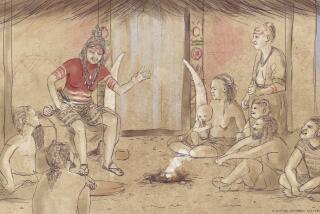Manot Cave skull suggests link between Neanderthals and modern humans
- Share via
It was sealed off from humanity for 30,000 years before sewer workers accidentally shattered its vaulted ceiling, allowing Israeli searchers to rappel into its dark interior.
Sweeping the cave’s damp walls and mineral spires with flashlights, the visitors discovered a trove of charcoal-smudged hearths, animal bones and Stone Age tools. And in one spot, they found the bowl-shaped fragment of a distinctly human skull.
Seven years after the discovery of Manot Cave in western Galilee, researchers argued in Nature this week that the 55,000-year-old skull cap may have belonged to a hypothesized group of modern humans who, after venturing out of Africa, associated and interbred with Neanderthals in the Middle East and then moved on to colonize Europe.
“Before now we had a theory, but we didn’t have the evidence,” said lead study author Israel Hershkovitz, a professor of anatomy at Tel Aviv University. “This is the first specimen that connects the continents.”
Scientists who pieced together the Neanderthal genome have shown that roughly 2% of the DNA of all non-African people alive today derives from these extinct relatives.
This evidence of interbreeding marks a reunion of sorts: Modern humans and Neanderthals shared a common ancestor in Africa more than half a million years ago before pursuing separate evolutionary paths.
But whether this reunion actually occurred in the Levant, Europe or Asia remains a matter of debate. Evolutionary geneticists say it most likely occurred 50,000 to 60,000 years ago, a time when the Middle East was probably a Stone Age crossroads for modern humans and Neanderthals.
Hershkovitz and his colleagues used radiometric dating techniques to estimate how long minerals in the Israeli cave had been accumulating on the Manot skull. They arrived at an age of 54,700 years old, give or take 5,500 years.
That estimate coincides with the theorized mass movement of modern humans out of Africa, at a time when a wetter climate allowed them to penetrate the continent’s formidable desert barriers.
The Manot skull is by no means the oldest evidence of modern humans in the region. In Israel’s nearby Skhul and Qafzeh caves, researchers have uncovered early modern human remains that are 100,000 years old.
However, Hershkovitz and his colleagues argue that these remains represent waves of humanity that departed Africa much earlier, only to meet a dead end. For unknown reasons, they became extinct before they could migrate to Europe or Asia.
The people who inhabited Manot fared much better, the researchers say, and probably coexisted with an established Neanderthal population there for up to 5,000 years.
“They were neighbors,” Hershkovitz said.
Hershkovitz and his colleagues said the skull fragment may well be the missing piece of a larger puzzle that shows how Neanderthals and modern humans may have mixed their genes. But other researchers said they needed more proof.
John Shea, a paleoanthropologist at Stony Brook University in New York who was not involved in the Nature study, said he agreed that the skull belonged to a modern human. However, he added, that did not mean he or she mingled with Neanderthals.
The best way to prove that modern humans and Neanderthals actually coexisted and interbred would be to find their remains in the same area, he said.
“If these guys could truly tolerate each other’s presence — humans and Neanderthals — we ought to be able to find their remains enclosed in the same sedimentary deposits,” Shea said. “If we had two skulls, one with human morphology and the other Neanderthal, I’d say, ‘Game over. You’ve won.’”
John Hawks, a University of Wisconsin anthropologist who was not involved in the study, said the discovery of the skull was significant because it was found at the time and place where “interesting exchanges between archaic and modern humans may have been happening.”
Still, he added, the skull is more tantalizing than conclusive.
“I wish there were more,” Hawks said. “Unfortunately, this part of the skull does not tell us about the face, or really much about the adaptation of this person.… Hopefully, they will find more evidence.”
Hershkovitz said that more research — and perhaps more discoveries — was forthcoming. Scientists are analyzing foot and chest bones recovered along with the skull fragment, and more than 32 feet of unexcavated material within the cave will keep archaeologists busy for years to come.
The researchers hope they can extract DNA from the skull, which might provide further evidence of interbreeding between the two groups. But there is no guarantee the ancient bone will yield useful genetic material.
“If we’re lucky enough to extract DNA from this skull, we will have an answer,” Hershkovitz said. “If not, we’ll never know.”
Twitter: @montemorin







